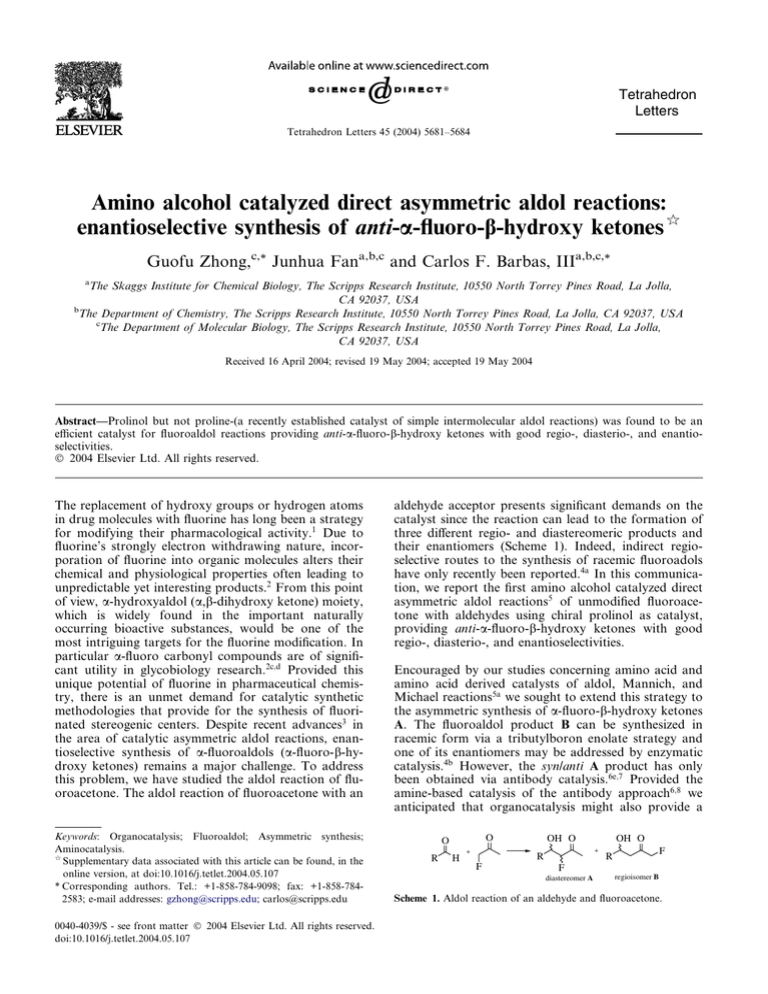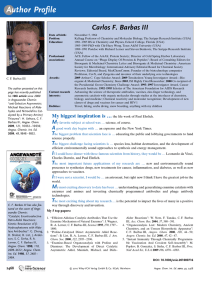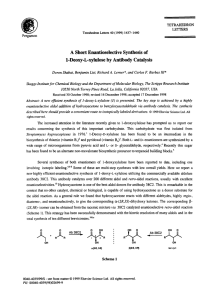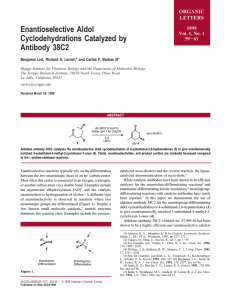
Tetrahedron
Letters
Tetrahedron Letters 45 (2004) 5681–5684
Amino alcohol catalyzed direct asymmetric aldol reactions:
enantioselective synthesis of anti-a-fluoro-b-hydroxy ketones q
Guofu Zhong,c,* Junhua Fana,b,c and Carlos F. Barbas, IIIa,b,c,*
a
The Skaggs Institute for Chemical Biology, The Scripps Research Institute, 10550 North Torrey Pines Road, La Jolla,
CA 92037, USA
b
The Department of Chemistry, The Scripps Research Institute, 10550 North Torrey Pines Road, La Jolla, CA 92037, USA
c
The Department of Molecular Biology, The Scripps Research Institute, 10550 North Torrey Pines Road, La Jolla,
CA 92037, USA
Received 16 April 2004; revised 19 May 2004; accepted 19 May 2004
Abstract—Prolinol but not proline-(a recently established catalyst of simple intermolecular aldol reactions) was found to be an
efficient catalyst for fluoroaldol reactions providing anti-a-fluoro-b-hydroxy ketones with good regio-, diasterio-, and enantioselectivities.
Ó 2004 Elsevier Ltd. All rights reserved.
The replacement of hydroxy groups or hydrogen atoms
in drug molecules with fluorine has long been a strategy
for modifying their pharmacological activity.1 Due to
fluorine’s strongly electron withdrawing nature, incorporation of fluorine into organic molecules alters their
chemical and physiological properties often leading to
unpredictable yet interesting products.2 From this point
of view, a-hydroxyaldol (a,b-dihydroxy ketone) moiety,
which is widely found in the important naturally
occurring bioactive substances, would be one of the
most intriguing targets for the fluorine modification. In
particular a-fluoro carbonyl compounds are of significant utility in glycobiology research.2c;d Provided this
unique potential of fluorine in pharmaceutical chemistry, there is an unmet demand for catalytic synthetic
methodologies that provide for the synthesis of fluorinated stereogenic centers. Despite recent advances3 in
the area of catalytic asymmetric aldol reactions, enantioselective synthesis of a-fluoroaldols (a-fluoro-b-hydroxy ketones) remains a major challenge. To address
this problem, we have studied the aldol reaction of fluoroacetone. The aldol reaction of fluoroacetone with an
Keywords: Organocatalysis; Fluoroaldol; Asymmetric synthesis;
Aminocatalysis.
q
Supplementary data associated with this article can be found, in the
online version, at doi:10.1016/j.tetlet.2004.05.107
* Corresponding authors. Tel.: +1-858-784-9098; fax: +1-858-7842583; e-mail addresses: gzhong@scripps.edu; carlos@scripps.edu
0040-4039/$ - see front matter Ó 2004 Elsevier Ltd. All rights reserved.
doi:10.1016/j.tetlet.2004.05.107
aldehyde acceptor presents significant demands on the
catalyst since the reaction can lead to the formation of
three different regio- and diastereomeric products and
their enantiomers (Scheme 1). Indeed, indirect regioselective routes to the synthesis of racemic fluoroadols
have only recently been reported.4a In this communication, we report the first amino alcohol catalyzed direct
asymmetric aldol reactions5 of unmodified fluoroacetone with aldehydes using chiral prolinol as catalyst,
providing anti-a-fluoro-b-hydroxy ketones with good
regio-, diasterio-, and enantioselectivities.
Encouraged by our studies concerning amino acid and
amino acid derived catalysts of aldol, Mannich, and
Michael reactions5a we sought to extend this strategy to
the asymmetric synthesis of a-fluoro-b-hydroxy ketones
A. The fluoroaldol product B can be synthesized in
racemic form via a tributylboron enolate strategy and
one of its enantiomers may be addressed by enzymatic
catalysis.4b However, the syn/anti A product has only
been obtained via antibody catalysis.6e;7 Provided the
amine-based catalysis of the antibody approach6;8 we
anticipated that organocatalysis might also provide a
O
O
R
H
+
OH O
F
OH O
+
R
F
R
F
diastereomer A
regioisomer B
Scheme 1. Aldol reaction of an aldehyde and fluoroacetone.
5682
G. Zhong et al. / Tetrahedron Letters 45 (2004) 5681–5684
solution to this synthetic challenge. Initial studies of the
aldol reaction of 4-nitrobenzaldhyde and fluoroacetone
mediated by L -proline or 5,5-dimethyl thiazolidinium-4carboxylate (DMTC) catalyst, the most promising
amino acids described for the aldol reaction, were disappointing and yielded a complex mixture of products.
Catalyst screening was then performed. Following the
screening method used in the search for class I aldolase
antibodies,6;8 a mechanism-based simple b-diketone
(2,4-pentanedione) was employed to report on a catalysts ability to form enamines via an enaminone reporter
group. Of the amines tested, those that produced the
characteristic enaminone absorption maximum at
316 nm after incubation with 2,4-pentanedione in
DMSO, were shown to possess aldolase activity. Among
the catalysts identified was L -prolinol, which demonstrated strong enaminone absorption after mixing with
2,4-pentanedione in DMSO. Catalysts were then studied
for their ability to catalyze the fluoroaldol addition
reaction. When a solution of 4-nitrobenzaldhyde
(1.0 mmol) and L -prolinol (35 mol %) in fluoroacetone/
DMSO (2.0 mL/10 mL) was maintained at room temperature for 2 days, the three-fluoroaldol products, anti1, syn-1, and regioisomer-1 (B, when R ¼ 4-nitrophenyl
in Scheme 1), were cleanly formed in 82% yield. The
products were formed with promising diastereoselectivity dr (anti-1/syn-1) 7:39 and excellent regioselectivity,
94%. Significantly the ee of the major product anti-1 was
determined by chiral-phase HPLC to be 84% (Eq. 1).
Solvent screening showed that DMSO and 1,4-dioxane
were optimal solvents with respect to the enantioselectivity of the reaction.
O
H
O
35 mol%
F
DMSO O N
2d
2
+
O2N
OH O
L-Prolinol
F
ð1Þ
1
ee 84%
anti/syn = 7:3
regioselectivity: 94%
yield 82%
This result prompted us to study the generality of the
prolinol catalyzed fluoroaldol reaction. As shown in
Table 1, a-fluoroaldols could be prepared using aliphatic
aldehydes as acceptors in moderate yields (entry 5 and 6:
34% and 29%) and with increased yields in cases
involving aromatic aldehydes (entries 1–4: 50–72%). The
diastereoselectivity of the reactions were typically good,
dr (anti/syn) from 7:3 to 10:1. In most cases, the products were formed with very high regioselectivities (over
20:1) and with the anti-a-fluoro-b-hydroxy ketones as
the major products. An exception is entry 3 were regioisomer-B was obtained as main product (A/B ¼ 1:4).
Most significantly the anti-a-fluoroaldols (1–6) were
consistently obtained with good enantioselectivities (79–
87% ee).
The absolute configurations of anti-a-fluoroaldols 3–6
were assigned based on the X-ray crystal structure of
anti-a-fluoroaldol 1 (Fig. 1) and assignment of anti-afluoroaldol 2.10 The observed enantioselectivities of the
reactions can be rationalized by invoking an enamine
mechanism operating through a chair transition state
where the si-face of an E-enamine of fluoroacetone and
L -prolinol attacks the re-face of the aldehyde to provide
the anti-a-fluoroaldol product (Fig. 2).
The availability of both L - and D -prolinol provides for
the enantioselective synthesis of both enantiomers of
anti-a-fluoroaldols with good ee. Further, the b-diketone 2,4-pentanedione can be used for screening small
molecule aldol catalysts that use an enamine mechanism. Studies addressing the synthetic scope of prolinol
catalysis in asymmetric reactions are ongoing.11
Typical experimental procedure: To a solution of the
aldehyde (1.0 mmol) and fluoroacetone (2.0 mL) in
anhydrous DMSO (10 mL), L -prolinol (35 mol %) or D prolinol was added. The resulting homogeneous reaction mixture was kept at room temperature for 1–4 days.
Table 1. anti-a-Fluoroaldols prepared from prolinol catalyzed aldol reactions of aldehydes and fluoroacetone
L-Prolinol
O
O
R
H
+
35 mol%
DMSO
1-4d
F
R
1
2
p-O2 N-Phenyl
Phenyl
O
+ regioisomer
R
F
Dra (anti/syn)
Entry
OH
Yield (%)b
Regioselectivityc (A/B)
ee (%)d (anti)
7:3
9:1
82
72
47:3
>20:1
84
87
9:1
51
1:4
83
10:1
50
>20:1
85
5:1
3:1
34
29
>20:1
>20:1
80
79
H
N
3
4
O
O
N
O
S
5
6
a
Cyclohexyl
iso-Butyl
Determined by 1 H NMR spectroscopy.
Overall yield.
c
The ratio (A/B) is that of the diastereomers/regioisomer (see Scheme 1).
d
The ee of the anti-isomer was determined by chiral phase HPLC.
b
G. Zhong et al. / Tetrahedron Letters 45 (2004) 5681–5684
2.
Figure 1. The ORTEP plot of X-ray structure of anti-a-fluoroaldol 1.
3.
H
R
F
H
N
O H
H
O
Figure 2. Proposed transition state of the
roaldol reaction.
L -prolinol
catalyzed fluo-
4.
Then saturated NH4 Cl was added. The reaction mixture
was extracted with ethyl acetate. The extracts were dried
over MgSO4 . Evaporation of solvent followed by flash
column chromatography on silica gel to give regio- and
diastereo-products separately. Enantiomeric excesses
and diastereoselectivities of the anti-fluoroaldols were
measured by chiral phase HPLC and 1 H NMR analysis.
Racemic fluoroaldol products were prepared similarly
using D L -prolinol as catalyst. The ee was determined by
chiral-phase HPLC with hexane/iso-propanol.
(3S,4S)-3-Fluoro-4-hydroxy-4-(40 -nitrophenyl)-butan-2one (anti-1) from L -prolinol catalysis: 1 H NMR
(300 MHz, CDCl3 ): d 8.23 (2H, d, J 8.8), 7.57 (2H, d, J
8.8), 5.19 (1H, dd, J 14.3, 5.7), 4.84 (1H, dd, J 48.8, 5.7),
2.22 (3H, d, J 5.3); 13 C NMR (400 MHz, CDCl3 ): d
207.3, 148.0, 144.7, 127.9, 123.7, 94.8, 72.7, 27.4; HPLC
(Daicel Chiralpak AS, i-propanol/hexane ¼ 15:85, flow
rate 1.0 mL/min, k ¼ 254 nm): tminor ¼ 12:7 min, tmajor ¼
15:4 min, ee 84%; HR-MS (MALDI-FTMS): 250.0489;
C10 H10 FNO4 Naþ (calcd 250.0486).
5.
6.
Supplementary material
Complete analytical data for all new compounds, data
from solvent screen, and X-ray structure data. The
supplementary data is available online in ScienceDirect.
7.
Acknowledgements
This study was supported by the NIH (CA27489) and
The Skaggs Institute for Chemical Biology. We thank
Raj K. Chadha for X-ray crystal structure determination of anti-a-fluoroaldol 1.
8.
9.
10.
References and notes
1. (a) Asymmetric Fluoroorganic Chemistry: Synthesis, Applications and Future Directions; Ramachandran, P. V., Ed.;
American Chemical Society: Washington, DC, 2000; (b)
Biomedical Frontiers of Fluorine Chemistry; Ojima, I.,
McCarthy, J. R., Welch, J. T., Eds.; American Chemical
11.
5683
Society: Washington, DC, 1996; (c) Welch, J. T.; Eswarakrishnan, S. In Fluorine in Bioorganic Chemistry; John
Wiley & Sons: New York, 1990; (d) Resnati, G. Tetrahedron 1993, 49, 9385.
(a) Greedy, B.; Paris, J.-M.; Vidal, T.; Gouverneur, V.
Angew. Chem., Int. Ed. 2003, 42, 3291; (b) Mu~
niz, K.
Angew. Chem., Int. Ed. 2001, 40, 1653; (c) Burkart, M. D.;
Zhang, Z.; Hung, S.-C.; Wong, C.-H. J. Am. Chem. Soc.
1997, 119, 11743; (d) Davis, F. A.; Zhou, P.; Murphy, C.
K.; Sundarababu, G.; Qi, H.; Han, W.; Przeslawski, R.
M.; Chen, B.-C.; Carroll, P. J. J. Org. Chem. 1998, 63,
2273.
For reviews of the enantioselective aldol reaction, see: (a)
Carreira, E. M. In Comprehensive Asymmetric Catalysis;
Jacobsen, E. N., Pfaltz, A., Yamamoto, H., Eds.; Springer: Heidelberg, 1999; Vol. 3, Chapter 29.1; (b) Machajewski, T. D.; Wong, C.-H. Angew. Chem., Int. Ed. 2000, 39,
1352; (c) Nelson, S. G. Tetrahedron: Asymmetry 1998, 9,
357; (d) Gr€
oger, H.; Vogel, E. M.; Shibasaki, M. Chem.
Eur. J. 1998, 4, 1137.
For chemical synthesis of a-fluoro-b-hydroxy ketones, see:
(a) Sinha, S. C.; Dutta, S.; Sun, J. Tetrahedron Lett. 1999,
41, 2000; For enzymatic synthesis, see: (b) Barbas, C. F.,
III; Wang, Y.-F.; Wong, C.-H. J. Am. Chem. Soc. 1990,
112, 2013.
For direct catalytic asymmetric aldol reactions, see: (a)
Sakthivel, K.; Notz, W.; Bui, T.; Barbas, C. F., III. J. Am.
Chem. Soc. 2001, 123, 5260; (b) Mase, N.; Tanaka, F.;
Barbas, C. F., III. Org. Lett. 2003, 5, 4369; (c) Mase, N.;
Tanaka, F.; Barbas, C. F., III. Angew. Chem., Int. Ed.
2004, 43, 2420; (d) Yoshikawa, N.; Yamada, Y. M. A.;
Das, J.; Sasai, H.; Shibasaki, M. J. Am. Chem. Soc. 1999,
121, 4168; For organocatalytic Mannich reactions see: (e)
Notz, W.; Tanaka, F.; Watanabe, S.; Chowdari, N. S.;
Turner, J. M.; Thayumanavan, R.; Barbas, C. F., III.
J. Org. Chem. 2003, 68, 9624; For organocatalytic Michael
reactions see: (f) Betancort, J. M.; Barbas, C. F., III. Org.
Lett. 2001, 3, 3737.
(a) Wagner, J.; Lerner, R. A.; Barbas, C. F., III. Science
1995, 270, 1797; (b) Bj€
ornestedt, R.; Zhong, G.; Lerner, R.
A.; Barbas, C. F., III. J. Am. Chem. Soc. 1996, 118, 11720;
(c) Zhong, G.; Hoffmann, T.; Lerner, R. A.; Danishefsky,
S.; Barbas, C. F., III. J. Am. Chem. Soc. 1997, 119, 8131;
(d) Barbas, C. F., III; Heine, A.; Zhong, G.; Hoffmann, T.;
Gramatikova, S.; Bj€
ornestedt, R.; List, B.; Anderson, J.;
Stura, E. A.; Wilson, E. A.; Lerner, R. A. Science 1997,
278, 2085; (e) Hoffmann, T.; Zhong, G.; List, B.; Shabat,
D.; Anderson, J.; Gramatikova, S.; Lerner, R. A.; Barbas,
C. F., III. J. Am. Chem. Soc. 1998, 120, 2768; (f) Zhong,
G.; Shabat, D.; List, B.; Anderson, J.; Sinha, S. C.; Lerner,
R. A.; Barbas, C. F., III. Angew. Chem., Int. Ed. 1998, 37,
2481.
One report utilizing 1-fluoro-3,3-dimethylbutanone as a
donor provides a a-fluoro-b-hydroxy ketone A product,
where the formation of B is not possible, see: Welch, J. T.;
Seper, K. W. Tetrahedron Lett. 1984, 25, 5247.
Zhong, G.; Lerner, R. A.; Barbas, C. F., III. Angew.
Chem., Int. Ed. 1999, 38, 3738.
anti/syn Ratio was determined by 1 H NMR (the coupling
constants: JHHðanti HO–CH–CH–FÞ ¼ 5:7 Hz, JHHðsyn HO–CH–CH–FÞ ¼
2:6 Hz).
The absolute configuration of anti-a-fluoroaldol 2 was
assigned by conversion of it to known 4-phenyl-3(R),4(S)epoxybutanone, ½aD )81 (c 1.0, CHCl3 ) (see: lit. )87.7, c
1.32 in CHCl3 , 93% ee in Tetrahedron Lett. 1999, 40,
6069).
For methoxymethyl pyrrolidine (O-protected prolinol)
used as a chiral auxiliary in asymmetric syntheses, see
excellent review: (a) Enders, D.; Klatt, M. Synthesis 1996,
5684
G. Zhong et al. / Tetrahedron Letters 45 (2004) 5681–5684
1403; (b) L -Prolinol has been used as catalyst in the
asymmetric reduction of ketones with borane, see: Brunel,
J. M.; Maffei, M.; Buono, G. Tetrahedron: Asymmetry
1993, 4, 2255; and as a catalyst in the Robinson annulation reaction, see: (c) Bui, T.; Barbas, C. F., III.
Tetrahedron Lett. 2000, 41, 6951.






